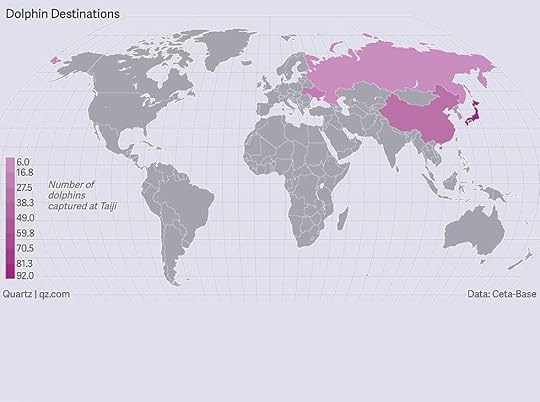Mark Caney's Blog, page 22
October 12, 2014
Killer Whales Learn How to Speak Dolphin
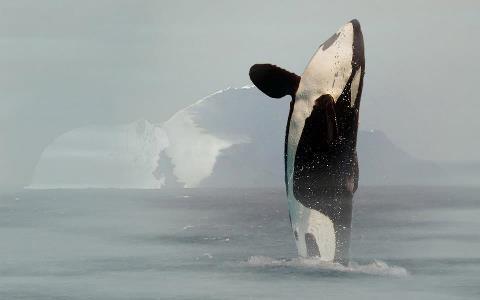 Killer whales are smart; that we know. Here’s a thing that might tip them into “scary smart” territory: they can learn the language of another species.
Killer whales are smart; that we know. Here’s a thing that might tip them into “scary smart” territory: they can learn the language of another species.
Orcas that were socialized with bottlenose dolphins started making similar sounds as the dolphins, with more clicks and fewer longer calls, according to a study by University of San Diego graduate student Whitney Musser and Hubbs-SeaWorld Research Institute senior research scientist Dr. Ann Bowles published in The Journal of the Acoustical Society of America.
Does this mean that killer whales have language, in the way that we understand it? It’s known that orcas communicate in so-called dialects, complex vocalizations comprised of clicks, whistles and pulsed calls. And whales that live together in the same pod use the same sounds to communicate, according to a press release.
“There’s been an idea for a long time that killer whales learn their dialect, but it isn’t enough to say they all have different dialects so therefore they learn. There needs to be some experimental proof so you can say how well they learn and what context promotes learning,” Bowles said.
Bats, some bird species and cetaceans, which includes whales and dolphins, have all exhibited vocal learning. Scientists know quite a lot about songbirds, since their small size makes it easy to study their brains and neural pathways, the press release said.
But, understandably, the sheer size of ceteceans makes it hard to study how they vocalize and learn. And since many ceteceans are under threat by habitat loss, global warming and human activities like commercial fishing, it’s more important than ever to find out more about them, according to the release.
“It’s important to understand how they acquire [their vocalization patterns], and lifelong, to what degree they can change it, because there are a number of different populations on the decline right now,” Bowles said. “And where killer whales go, we can expect other small whale species to go — it’s a broader question.”
Source: discovery.com
See also: Science Daily

October 11, 2014
Dolphins have a Magnetic Sense
Researchers observed a change in the behaviour of dolphins whenever they swim near magnetized objects. It was then found that they are sensitive to magnetic stimuli.
Lead researcher Dorothee Kremers and her colleagues at Ethos unit of the Universite de Rennes in France affirmed that they have behavioural evidence showing that these marine species are magnetoreceptive.
The researchers explained that magnetoreception is a sense, which allows an organism to detect a magnetic field to perceive direction, altitude or location. It is considered to play an important role as to how certain land and aquatic species orientate and navigate themselves.
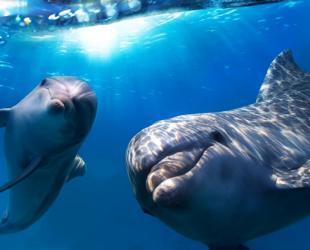
After observing some migration routes and certain stranding sites of whales, dolphins and porpoises, it has been suggested that they might be sensitive to geomagnetic fields.
Kremers and her colleagues affirmed that there was not enough experimental evidence on the same. Therefore, they started a study having an aim to know the behaviour of six bottlenose dolphins in the delphinarium of Planete Sauvage in Port-Saint-Pere in France.
The dolphins were either introduced in a barrel having a strongly magnetized block or in a barrel free of any magnetization. Except the magnetization part, the barrels were same. During the experimental sessions, the animals were allowed to freely swim in and out of the pools.
The researchers noticed that the dolphins’ approach rate towards the barrel having magnetized block was quite faster than the barrel not having any magnetization. It shall be noted that the dolphins did not show any type of difference while interacting with both the types of barrels.
Therefore, it can be said that the dolphins’ interest level was more towards the barrel having the magnetized block rather than being physically drawn towards the barrel.
“Our results provide new, experimentally obtained evidence that cetaceans have a magnetic sense, and should therefore be added to the list of magnetosensitive species”, stated Kremers.
Source: mainenewsonline

October 10, 2014
Crews attempt to rescue dolphin again
Rescuers will be back in the Gulf off of Pensacola Beach in the USA early Thursday trying once again to capture and remove fishing line from the tail of a bottlenose dolphin that’s been hanging out at the Pensacola Beach Gulf Pier for months.
This would be the fourth attempt to rescue the dolphin in the past two weeks. On Wednesday, the dolphin that pier anglers call “James” repeatedly outsmarted an armada of boats filled with members of the Southeast Marine Mammal Stranding Network trying to corral it in a net.
Weather and rough surf were blamed two weeks ago for failing to capture the young dolphin, thought to be about a year old.
Even with the help of spotters on the pier from the Fort Walton Beach Emerald Coast Wildlife Refuge, the rescuers could not trap the dolphin.
Instead, from 8:45 a.m. to 3 p.m. “James” spent much of the time swimming back and forth under the pier making corralling it too unsafe. It also led the five boats, including one from Sea World, about half a mile east before turning back to the pier where it has been hanging out at for about three to four months snacking on bait and catches, even tugging a few poles into the Gulf and stirring up animosity among the anglers.
“Most dolphins don’t eat bait,” Allan Towe said. “But this one does. He’s become dependent on this pier.”
Dolphins are known to snatch fish off of lines, which is likely how James became entangled in the first place.
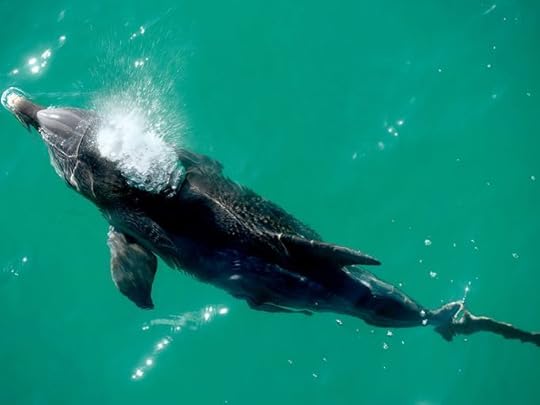
Full story: Pensacola New Journal

October 7, 2014
Hundreds of mourners attend moving funeral ceremony for a town’s favourite dolphin
They came in their hundreds, carrying flowers and weeping at the sight of a small blue coffin.
But these mourners were not marking the passing of a popular relative or friend but the death of a dolphin named Moko.
The bizarre ceremony took place in a small New Zealand town a week after its world-famous four-year-old bottlenose died.

Moko hit the headlines after saving the lives of stranded pygmy and sperm whales off the coast of Whakatane two years ago.
He then became a popular tourist attraction, with locals likening his behaviour to that of a boisterous teenager.
Helping to bury the mammal in a silk-lined blue coffin during a traditional ceremony, Pouroto Ngaropo, a senior Maori, said: ‘He wasn’t just a dolphin to the people around here.
‘He was loved, he was respected, he was fun, he was taken in as one of the members of the community.’
The body was found washed up on a beach at Matakana Island a week ago and it was there that prayers, poems and speeches of remembrance were uttered before he was buried, a small cross marking the spot.
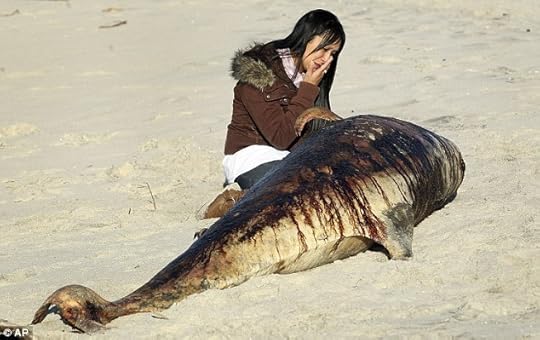

Not everyone loved the dolphin however, when he became rougher in his play, butting swimmers aggressively with his nose.
Female swimmers said they were concerned about what they believed was Moko’s strange attempts to mate with them and hurriedly left the water.
Fishermen were also left concerned after he started to attack their boats.
But he will be remembered more for his friendship than for his exuberance.
‘People have had a lot of enjoyment from interacting with him and learned lots about dolphins and cetaceans,’ said ranger Jamie Quirk.
‘He was a unique part of New Zealand history.’
The Conservation Department’s area manager, Mr Andrew Baucke, said Moko was a wild animal and his death could have been caused by any number of factors.
‘This is a sad loss,’ said Mr Baucke. ‘The way that Moko interacted with people really inspired public interest and care for dolphins and marine mammals and their environment in general.
‘I’m sure that those who got to see and swim with him will treasure those memories.’
While it is not known how Moko died, experts said his death may have been from natural causes.
Moko was not New Zealand’s first super-intelligent dolphin.
A Risso’s dolphin, named by his fans as Pelorus Jack, used to accompany ships travelling between Wellington, on the southern part of the North Island, to Nelson on the northern tip of the South Island.
He was first noticed in 1888 but when someone fired at him from a steamer in the early 1900s he became the first dolphin the world to be protected by law.

How he ultimately died was never established, with rumours ranging from him being killed by Norwegian whalers to him dying naturally.
Another famous bottlenose dolphin was Opo, who enjoyed playing with children in the 1950s. She was also buried in a traditional Maori ceremony.
Full story: Daily Mail

October 1, 2014
Simon Cowell’s Perfect Reaction To The X-Factor’s Dolphin Shows
When Simon Cowell found out that his show, The X-Factor, was going to air an episode that featured captive performing dolphins at a dolphinarium, the executive producer put down his foot.
The well-known animal activist was the target of a petition that gained over 7,000 signatures this week, calling on him to remove the segment from next week’s show. A teaser for the episode showed contestants swimming with the dolphins:
When the petition started gaining steam, Cowell took to Twitter to express his opinion:
Read more: The Dodo

September 30, 2014
Launching the Virgin Pledge on Sea Mammals
 Today, Richard Branson announced the Virgin Pledge and he confirmed that Virgin businesses will only continue to work with suppliers that pledge to no longer take sea mammals from the wild. He goes on to say: “We also looked into the issue of ending captivity, which is a cause of great importance to many. We didn’t find any easy answers, as simply releasing captive or captive-born cetaceans into the wild is currently not supported by most scientists concerned about the welfare of the animals. We will follow this debate very closely as it evolves.
Today, Richard Branson announced the Virgin Pledge and he confirmed that Virgin businesses will only continue to work with suppliers that pledge to no longer take sea mammals from the wild. He goes on to say: “We also looked into the issue of ending captivity, which is a cause of great importance to many. We didn’t find any easy answers, as simply releasing captive or captive-born cetaceans into the wild is currently not supported by most scientists concerned about the welfare of the animals. We will follow this debate very closely as it evolves.
In the last few weeks, our team has visited suppliers around the world to discuss critical issues and build support. We are releasing the names of those that have signed the Virgin Pledge on the Virgin Unite website today.
This is of course just the start of our journey. I am encouraged that Virgin Holidays have initiated a conversation that has education, conservation and the highest standard of care for these magnificent creatures at its heart.
We will also continue to champion other causes that advance ocean conservation, such as ending drive hunts and unregulated fisheries, or the creation of more marine protected areas.”

September 28, 2014
The many threats to dolphins and other cetaceans
By Milla de Villiers
There is NO nation that is totally innocent of harming dolphins. We do not see the suffering caused by many things which we are either unaware of or largely ignore. There is much that we all can do – we can all personally take responsibility for many things, and also lobby our respective governments to change destructive laws. Here a brief look at some of those threats.
BYCATCH OF CETACEANS
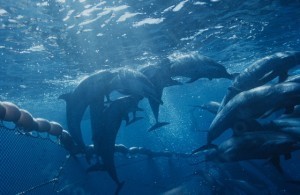 Dolphins and porpoises in particular are vulnerable to being caught and drowned in fishing nets, but larger whales are also prone. In excess of 300,000 cetaceans are estimated caught in fishing nets every year worldwide (Read et al 2003[1]). Although the majority of these are dolphins and porpoises, some large whales are vulnerable. The small and vulnerable North Atlantic Right Whale population in the north western Atlantic suffers several entanglements in nets every year. It is estimated that 72% of the current population have suffered entanglement at some time[2] http://www.marine-life.org.uk/conservation/threats-facing-the-marine-environment/bycatch
Dolphins and porpoises in particular are vulnerable to being caught and drowned in fishing nets, but larger whales are also prone. In excess of 300,000 cetaceans are estimated caught in fishing nets every year worldwide (Read et al 2003[1]). Although the majority of these are dolphins and porpoises, some large whales are vulnerable. The small and vulnerable North Atlantic Right Whale population in the north western Atlantic suffers several entanglements in nets every year. It is estimated that 72% of the current population have suffered entanglement at some time[2] http://www.marine-life.org.uk/conservation/threats-facing-the-marine-environment/bycatch
OVERFISHING
Most of the commercially viable fish stocks in the world are over-fished. Some are being driven to almost certain extinction, including the Blue-fin Tuna and several species of shark. However, it is not just the big predatory fish that are over-harvested; Anchovy and Sand Eels in European waters are among many species whose populations are in a poor state due to overfishing. These are important food sources for species further up the food chain, including seabirds and cetaceans, which are therefore put at risk. http://www.marine-life.org.uk/conservation/threats-facing-the-marine-environment/overfishing
MARINE NOISE POLLUTION
For many species of whale and dolphin sound is the primary sense, and is used to navigate, find food and communicate in an environment where smell is useless and sight nearly so, and sound is greatly enhanced compared with in air.
Shipping noise
Until little over 100 years ago the oceans were almost unaffected by human related noise. Modern propeller driven ships and smaller vessels are very noisy and increasingly abundant in many parts of the world, especially in highly populated areas like around European, southeast Asian or USA coasts. Here shipping noise is constant and intense, and is considered likely to interupt communication and food-finding in cetaceans.
Military activity
Recent developments in anti-submarine measures that generate very loud short pulses of sound have been implicated in some mass-strandings of particularly, but not only, beaked whales. Some animals have suffered damage to brain and other tissue associated with hearing and sound transmission, as well as other organs. Meanwhile others have suffered ‘the bends’ (nitrogen bubbles in the bloodstream) as a result of overly rapid surfacing from great depth, presumably as a panic response to the noise. Less acute, but nonetheless serious, is the displacement of animals during these operations, forcing them to abandon important foraging habitats. Marinelife has noted during systematic surveys, periods following naval exercises in Biscay when cetaceans are absent from a large area around where the exercise took place, which possibly points to significant displacement levels.
Seismic survey
Oil, gas and other under-sea mineral exploration commonly uses seismic surveys (creating pulses of intense noise and recording its transmission through the rock strata) to find new mineral reserves. Cetaceans are known to be displaced by seismic survey activity, which can last for several weeks in a given area.
Construction noise
Offshore construction is rapidly increasing, particularly the construction of large wind farms, but also building of bridges and other structures, which require prolonged pile-driving and even underwater use of explosives. This can cause behavioural changes in marine mammals up to 10km distance. http://www.marine-life.org.uk/conservation/threats-facing-the-marine-environment/marine-noise-pollution
POLLUTION
Pollution comes in many forms and has many impacts on the marine environment and marinelife that live there. Industrial and domestic pollution enters the marine environment mainly through rivers. But direct pollution from shipping is also significant.
Nutrients
Nutrients from agriculture, sewerage and industrial processes enter the sea in huge amounts. This can lead to algal blooms sometimes known as red tides, some of which can cause death in fish, marine mammals, birds etc.. Increased nutrient loads can also lead to reduction in dissolved oxygen. In many developed areas of the world, legislation is controlling the amount of eg untreated sewerage entering the sea.
Chemicals and heavy metals
These arise from land based industrial, atmospheric or ship sourced pollution and enter the food chain. The are concentrated in marine mammals and can cause reductions in fertility, reduced immunity from disease etc. Ironically, recently, Iceland whale meat exported to Japan was rejected because of excessive heavy metal content.
Plastics
Plastics are abundant polluters of the marine environment. Plastic sheeting, bags etc are commonly seen in shipping lanes and are mistaken by cetaceans, turtles and seabirds for food, and ingestion is often fatal. The impact is most famously to be seen in Laysan Albatrosses living in the Pacific Ocean that feed in the area known as the Pacific Gyre where huge volumes of plastic debris are concentrated by currents. Thousands die each year from plastic ingestion. However, seabirds in all oceans are at risk. A study of dead Fulmars in the North Sea found plastics in 98% of stomachs[1]. Balloons are also implicated. Plastic pollution also occurs as very fine granules, either direct from shore-based industrial emissions or from breakdown of plastics in the ocean. Granules often mimic plankton and are therefore eaten by plankton feeding marinelife. The plastics eventually break down and then release chemicals into the marine environment.
Oil pollution
Oil pollution from oil tanker wrecks, oil installation blow-outs and from illegal discharges at sea of fuel tanks is a well known and acute pollution source that kills a lot of the marinelife in the vacinity of the incident. The numbers of animals affected depends on many factors; proximity to breeding or wintering concentrations, size of spill, type of oil, sea currents and weather conditions. However the impact is probably longer and wider than immediately apparent as oil pollution will disperse, and break down and enter the foodchain. Pollution incidents continue with little evidence of success in reducing their frequency or impact, even though pollution monitoring has increased, and many incidents are missed.
Alien species
The rate at which species are being redistributed around the globe is increasing dramatically, often carried in seawater used as ballast by pan-global shipping – to balance the ship whilst transiting with little or no cargo. Taken on in one port and pump it out in another ocean. The seawater often includes fish, and crab larvae, algaes etc., some of which survive, and may thrive in their new home and can imbalance the ecosystem, either by predating on rare species or consuming their food source.
Shipping emissions
Most shipping uses low-grade bunker fuel oil, which has a sulphur content 2,000 times that of car diesel. The seas are a major sulphur sink (absorber), but the increased rates may lead to increasing acidification. Shipping emissions pollution is concentrated in the high shipping traffic areas, which include inshore European waters. Shipping is also considered to contribute 3.5-4% of all climate change emissions. However, research suggests that the same pollution helps form clouds which reflect solar heat back to space, so helping cool the planet. There are increasing moves to limit sulphur emissions from shipping, led by the UN. http://www.savethenorthsea.com/sa/node.asp?node=1404 http://www.marine-life.org.uk/conservation/threats-facing-the-marine-environment/pollution
SHIPPING
Whale and dolphin collisions with ships and pleasure craft are a potentially significant cause of mortality. The seas are busier now than ever before, and the size and speed of commercial shipping is increasing. Cetaceans, and other marinelife are not evolved to be able to adapt to these changes. The scale of the problem is very hard to assess as most large ship collisions go unreported and often unnoticed. Where shipping is concentrated on busy routes that pass through important marine mammal habitat it is inevitable that the risk of collision increases. In the case of rare species any deaths through collision are highly significant, and when the species range is restricted to areas with high shipping traffic, eg in the case of the North Atlantic Right Whale with a global population of less than 400 animals, the problem could be critical. More than 50% of the known deaths of North Atlantic Right Whales between 1970 and 2006 involved shipping collisions[1]. The small isolated Fin Whale population in the north western Mediterranean is also vulnerable. Concern has been expressed by ASCOBANS[2] about the proliferation of high speed ferries (traveling in excess of 30 knots) and the risk of collision with small as well as larger cetaceans in the English Channel in particular, but also in other high traffic areas. Fast ferries have limited manoeuvrability and the mammals have less time to react to their presence hence collision risk is increased. Small pleasure craft abound in coastal waters, and collisions are inevitable. Inshore dolphins often show injuries from high speed small propellers. The numbers of fatalities are impossible to quantify. There are even several documented cases of whale watching vessels fatally injuring whales! Species include Minke, Fin and Humpback Whales[3].
[1] http://www.wdcs.org/submissions_bin/shipstrikes.pdf
[2] ASCOBANS the Agreement on Small Cetaceans of the Baltic and North Sea. An agreement between governments on the conservation of small cetaceans, in an area that is now extended to include western European Atlantic http://www.ascobans.org/index0101.html
The summaries were all found here: http://www.marine-life.org.uk/conservation/threats-facing-the-marine-environment

September 18, 2014
Are dolphins cleverer than dogs?
A lone bottlenose dolphin swam into the harbour at Tory Island off the north coast of Ireland in April 2006. Her playfulness quickly earned her an appreciative following among the locals who nicknamed her Duggie. Her biggest fan was a Labrador retriever named Ben, who began swimming out to meet her on a daily basis.
During a typical encounter, Ben would paddle frantically with his tail wagging happily above the waves while Duggie blew giant bubble clouds around his canine companion. Ask most people which of the two species in this touching tale is the most intelligent and there is unlikely to be much of a contest. Dolphins – with their sociability, communication skills, playfulness and ability to understand the complex commands of trainers – are widely considered to be the second most intelligent of all animals after humans.
 Yet recent years have seen a growing interest in canine cognition. Researchers at institutes such as the Duke Canine Cognition Center, North Carolina, US, and the Dog Cognition Centre at the University of Portsmouth, UK, are concluding there is far more going on in the minds of dogs than we previously thought. In fact in some cognitive tests they outwit both great apes and dolphins. So what does the latest science say? Could dogs really be the intellectual rivals of dolphins?
Yet recent years have seen a growing interest in canine cognition. Researchers at institutes such as the Duke Canine Cognition Center, North Carolina, US, and the Dog Cognition Centre at the University of Portsmouth, UK, are concluding there is far more going on in the minds of dogs than we previously thought. In fact in some cognitive tests they outwit both great apes and dolphins. So what does the latest science say? Could dogs really be the intellectual rivals of dolphins?
“There’s lots of evidence that dogs are more skilled than primates at thinking about a person’s communicative intentions,” says Laurie R. Santos, a psychologist at Yale University in New Haven, Connecticut, US, who studies primates and canines to shed light on the human mind. “They understand that people are trying to communicate information and use such communicative signals way better than primates do.”
Understanding us
Dogs’ abilities to comprehend human communicative signals make them one of the only animals to understand what people mean when they point at something. Even our cognitive cousins the chimpanzees don’t look past the tip of an outstretched finger when a human points them in the direction of food. A dog can use pointing as well as eye-direction cues to locate objects in the distance. These abilities are rare in the animal kingdom, although dolphins have them too, so on this test alone dogs don’t best them in a contest of wits.
There is however one cognitive feat at which dogs, somewhat unexpectedly, outshine almost every other non-human animal. Chaser, a Border Collie trained by US psychologists, is reported to be able to understand over 1,000 words used by her trainers to label her toys. When asked to fetch Bamboozle, a stuffed orange horse, she is easily able to pick it out of a lineup of other toys. She is even able to understand simple sentences consisting of a preposition, two nouns, and a verb, like “to Frisbee take ball” (take the ball to the Frisbee). With research showing the famous language-trained apes like Kanzi the Bonobo top out at vocabularies of less than half those of Chaser, and the dolphin language prodigies from the Kewalo Basin Marine Mammal Laboratory only managing about 40 words, dogs come out top when it comes to learning the meaning of individual symbols.
More than words
But there’s more to language comprehension than just vocab. Although Chaser was able to understand some basic syntax-like structure, scientists working with dolphins have succeeded in combining up to five words in one sentence containing complex concepts like “through” or “imitate.” This allows dolphins to comprehend thousands of different sentences that involve much more complex behaviour than simply “fetching.”
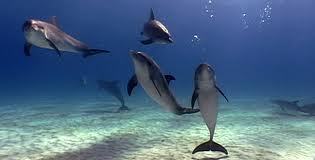 And unlike dogs, it seems that dolphins are keen problem solvers.
And unlike dogs, it seems that dolphins are keen problem solvers.
In one experiment, dolphins were tasked with retrieving a series of weights scattered around their pool which they had to place on top of a box in order to release a food reward. Almost immediately they hit upon the idea of collecting all of the weights at the same time instead of placing them on the box one at a time. This apparent flash of insight suggests the dolphins were planning their behaviour and turning over possible solutions in their mind’s eye; a hallmark of complex thinking.
On top of this, dolphins are among the handful of animals that understand they are looking at themselves when put in front of a mirror (others include chimpanzees, elephants, and magpies). Researchers have used the mirror self-recognition test to determine whether animals understand that they exist as separate entities in the world, with their own thoughts and minds. This level of self-awareness opens the door to greater flexibility in the face of new problems, or when trying to figure out what’s going on inside the minds of other animals. In this particular test of intelligence, dogs don’t make the grade.
At first glance then, perhaps dolphins’ superior word-crunching skills, problem solving, and self-awareness mean the gut instincts of those who assume they outsmart dogs are supported by the evidence. But relying on our gut to evaluate intelligence is problematic.
For one thing, the concept of human intelligence itself is an ill-defined amalgamation of various different cognitive skills, and efforts to evaluate it such as IQ tests are plagued by cultural bias. Is someone who is good at solving algebraic equations more intelligent than someone who can quickly determine the motivations of others? Is being able to remember facts a mark of cleverness, and is it more or less important than logical reasoning?
The difficulties such questions pose help explain why many scientists object to subjective notions of human intelligence being applied to non-human animals.
Furthermore, even if it were possible to agree on a constant and universally-accepted definition of human intelligence, why should this apply to non-human animals?
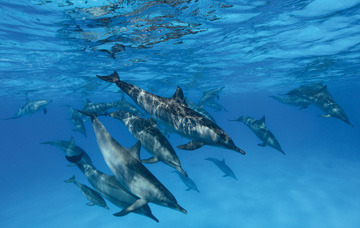 Dogs have been bred to thrive in a human-generated environment; they’re particularly adept at reading human social cues, and tugging on human heart strings. When we look into their eyes and see a glimmer of intelligence, we see a reflection of our own minds. The skills at which they excel – understanding pointing or object labels – are predominately a result of humans having spent thousands of years breeding them to understand concepts that are important to us. We are the architects of their minds in many ways, and we’ve shaped them to conform to our definitions of intelligence.
Dogs have been bred to thrive in a human-generated environment; they’re particularly adept at reading human social cues, and tugging on human heart strings. When we look into their eyes and see a glimmer of intelligence, we see a reflection of our own minds. The skills at which they excel – understanding pointing or object labels – are predominately a result of humans having spent thousands of years breeding them to understand concepts that are important to us. We are the architects of their minds in many ways, and we’ve shaped them to conform to our definitions of intelligence.
Dolphins, on the other hand, have evolved their cognitive skillset in a world untouched by humans. Yet they seem intelligent to us because their complex social behaviour reminds us of ourselves. We see reflections of humanity in their playful demeanour and intricate societies. And when scientists began digging into dolphin minds, they found abilities that closely resembled that of our fellow great apes, such as mirror self-recognition – an unexpected finding for an animal that looks more like a tuna than a chimpanzee. Dolphins are perhaps the most human-like of all non-primates, which is precisely why we consider them to be intelligent.
Full story: BBC

September 16, 2014
Russia confirms Putin is chief of highly-trained ‘spy dolphin’ units
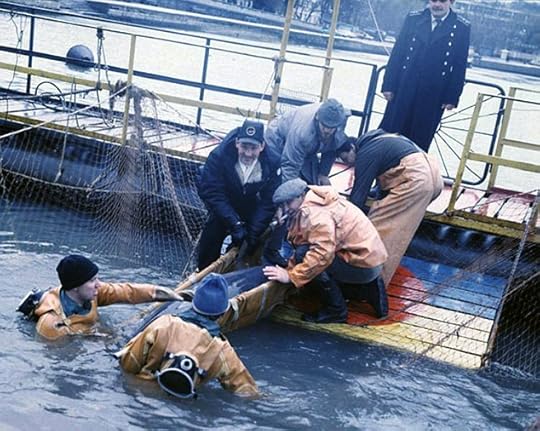 Russia has formally acknowledged that it has conscripted Ukraine’s ‘spy dolphins’ which means they could now be used in underwater naval operations against the West.
Russia has formally acknowledged that it has conscripted Ukraine’s ‘spy dolphins’ which means they could now be used in underwater naval operations against the West.
The specially trained mammals were seized when Russia annexed Crimea in March, and now Moscow has officially ruled out handing them back.
The combat dolphins are trained for military duties at the Crimean State Oceanarium, which was inherited by Ukraine when the Soviet Union collapsed 23 years ago.
Acting Sevastopol governor Sergei Menyailo said: ‘The jurisdiction over this facility has been fully transferred to the Russian Defence Ministry.’
Moscow has taken charge of 13 elite unit of dolphins and a number of sea lions.
The creatures are trained to hunt for mines, plant bombs on hostile ships or attack enemy divers with special knives or pistols fixed to their heads.
Others were schooled for anti-sabotage and rescue missions.
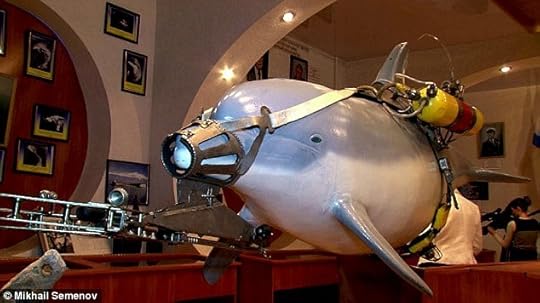 The use of bottlenose dolphins as naval assets was begun during the Cold War in Sevastopol by the Soviet Union in 1973.
The use of bottlenose dolphins as naval assets was begun during the Cold War in Sevastopol by the Soviet Union in 1973.
NATO is now running constant patrols in the Black Sea due to the Ukrainian crisis, which means in theory that Russia could deploy them against Western ships.
Four other dolphins used in Sevastopol in helping to treat children suffering from cerebral palsy, mental disorders and psychological stress have been moved to civilian duties by the Russians and will continue this valuable work.
In March, the Russian media reported that the dolphins had ‘defected’ to Moscow – along with many Ukrainian forces in Crimea – but this is the first official confirmation that the mammals’ commander in chief is now Vladimir Putin.
In July a Ukrainian official demanded that the dolphins should be handed back to Ukraine.
‘The military dolphins need to be returned to our country in the same way that Russia returned Ukraine’s seized military equipment,’ he said.
Last year three of five spy dolphins went absent without leave in the Black Sea – apparently in search of love.
‘They deserted a naval exercise and went on manoeuvres of an amorous kind,’ said a source. ‘They swam away to look for mates.’
Later they returned to duties.Yury Plyachenko, a former Soviet naval anti-sabotage officer, explained that this was something that had to be taken into account in working with the 007 mammals.
‘If a male dolphin saw a female dolphin during the mating season, then he would immediately set off after her. But they come back in a week or so.’
The Sevastopol facility is one of only two such combat dolphin training centres in the world. The other is run by the US Navy in San Diego.
Full story and video: Daily Mail

September 15, 2014
Map Shows Where Dolphins Captured at the Cove in 2013 Were Sold
As the annual dolphin-killing season begins at the cove at Taiji, Japan, the focus will be on the slaughter. Far less attention will be paid, however, to the fate of dolphins captured and sold to marine-mammal entertainment parks worldwide.
But some activists are bringing their fight to facilities that fuel demand for live dolphins.
Live dolphins are far more lucrative than dead ones. Taiji fishermen can earn $150,000 or more from selling a single live animal, while one butchered for meat fetches only $500 to $600, an economic reality that keeps the drives in business, opponents say.
It is impossible to know the final fate of all dolphins captured in Taiji. The Japanese government does not keep figures, nor does the World Association of Zoos and Aquariums. Most information comes from newspapers, activists on the ground, or people in countries where dolphins are destined to perform for or swim with tourists.
One website, Ceta-Base, tracks captive cetaceans and documents about where some, but not all, Taiji dolphins go. There were about 300 live captures in Taiji in 2013, according to the site, but information only exists on about half of those animals. Here’s the count: 92 dolphins were transferred to Japan, 36 went to China, 20 to Ukraine, 11 to Russia, six to South Korea, and five to Vietnam.
Worldwide, 105 facilities in about 20 countries import or display dolphins obtained from Taiji, according to Ceta-Base.
Kish Dolphin Park in Iran, for example, imported 12 dolphins in 2008. Dolphinarium NEMO, in Ukraine, bought 36 dolphins between 2010 and 2013; Saudi Arabia’s Fakieh Aquarium purchased six dolphins in 2013; and Cabo Adventures, a swim-with park in Baja, Mexico (the only site in the Americas with Taiji dolphins), imported seven animals in 2005.
Many animals never leave Taiji, including Angel, an albino calf captured in January and now on display at the Taiji Whale Museum.
Full story: Takepart


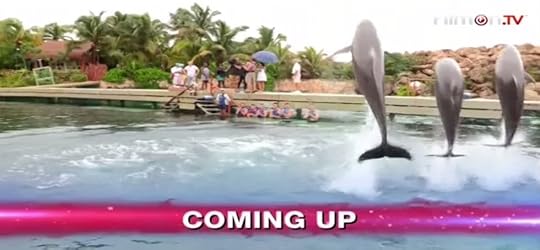 (
(
